|
Wednesday, May 7, 2025
GUEST BLOGGER: MUDI'S MEMOIRS - PART 5
THE
FISH BUSINESS Written and told by Helen Kavanaugh Tobbe (1905-2002) and transcribed
by her youngest child, Kate Tobbe Ptak. Before starting with Mudi's memories of the fish business and family stories related to it, let's set
the scene. As many of you know, Bay City is near the mouth of the Saginaw River, which feeds into Saginaw Bay,
which leads into Lake Huron. Point AuGres is on the northern part of the western shore of the bay near the lake. Crossing Saginaw Bay from Bay
City to AuGres was about a three-to-four-hour ride on one of the fish tugs in those times (1915 to 1930). North of Point AuGres are Point lookout, Tawas, Oscoda, Black River, and Alpena. W.P. had fish houses in Oscoda,
Black River, and Alpena as well as Au Gres and Essexville. WP had one of the largest fish
companies in Michigan at the time.
WP had a big fishery at AuGres. Jr. and I would often ride up to AuGres on one of the fish boats and stay at the fish
house for a few days. Among other entertainments Jr. and I loved to watch the tour
boat unload passengers
up at Point Lookout, which was an elegant resort with beautiful homes on the northern tip of the bay. There was a pleasure boat that took people from Wenona Beach near Bay City to Point Lookout to visit friends in their "cottages"
rather than tour shops, cafes, etc. 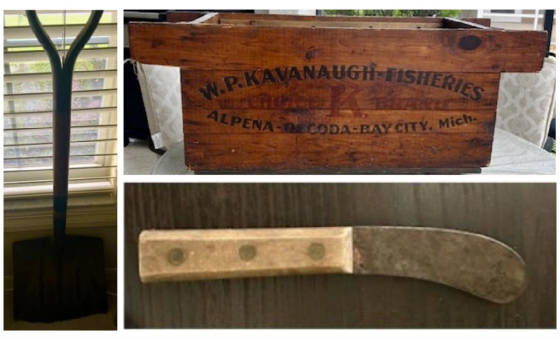
Image: Tool & Fish Box. Left:
Shovel for adding ice around the fish. Top right: Fish box used for shipping to New York and other locations.
Top bottom: Fish gutting knife. (In those days the pine wood used for these boxes was very cheap, equivalent to
cardboard we use today for shipping. When a box was emptied it was thrown on a pile for burning.)
It was at AuGres that the fish boats brought the catch in for boxing, then loaded back onto the tugboats to be taken to Essexville to be prepared for loading onto trains
to be shipped east to such places as the Fulton Fish Market in New York City.
The whole operation was on a tight schedule for the fish had to be ready to leave Essexville by 5:00 PM to make the train for New York
A typical
day started with the fishermen going out on the lake
at about 4:00 AM to harvest the fish caught in the nets over the last 24 hours and re-set the nets for the next day's catch. Pound nets or gill nets made of linen and high-grade cotton
were used, which were the strongest, most water worthy nets available in those days. The
fishermen would get back to the AuGres fish house about 7:00 AM. The
fish had to be put on ice in crates to
be shipped to Bay City. The tugs had
to leave AuGres about eleven. They arrived at the
Essexville fish house between 2:00 and 3:00 PM to be re-iced and re-boxed and ready for the 5:00 PM train. The train arrived in New York early the next morning, and the fish were sold at the market that day. I remember at least one occasion when WP had his men block the tracks with their wagons so that the train couldn't leave until all the fish were loaded.
WP built the fish house in AuGres
for his operation. Tons of fish were being boxed and iced there. A Prussian couple named Spaek ran the boarding house
for the fishermen. Mrs. Spaek was the housekeeper and cook. Her husband farmed the land - he was NOT a fisherman. They had their big Thanksgiving feast in early spring, because the operation was closed for the winter. Ice on the lake and bay made fishing in late fall and winter too dangerous. WP had to cut his own ice and
maintain ice houses for the boxing operations, which kept those men employed who
wanted to work through the winter. Many
of the men didn't. Many of the fishermen were Indians. Often,
many of the Indian
fishermen would go back to their villages and families for the winter. WP
experimented with a rail car that would be a freshwater tank, so the fish could arrive
in the east still swimming. He was successful in his design, but it was too
expensive to be practical.
One summer, WP decided to create a fishpond up
at AuGres so that he could keep the fish alive and swimming, to be shipped later
in the year when prices were higher. To create the fishpond required blasting. WP wanted to be on site
for this procedure, so prepared to spend most of the summer in AuGres. Nellie and we kids didn't want to
be left alone in Bay City,
so we convinced WP to bring us up to AuGres
for the summer as well. The fish house up there
had rooms for the fishermen, but no extra space for the family, so WP set up tents
for us. Besides the immediate family, Tim Lynch, my second cousin, and Aunt Aggie,
a first cousin of Grandma Callahan was
along. Mosquitoes
finally drove the family out of the tents. If we could keep very quiet so the
fishermen could get their much-needed sleep, the family could stay on the
porch. We tried to honor this deal,
but didn't always succeed. One hot sticky night, Aunt Aggie set a glass down on a table. Tim Lynch
heard a clinking sound as she set the glass down but couldn't see the contents
of the glass. The clinking sounded like ice cubes, which were reserved for the adults'
drinks, but he was so hot and thirsty that he grabbed the glass to take a big cool drink.
Aunt Aggie spotted him doing this and let out a screech - "My
teeth! Watch my teeth!" There wasn't much quiet that
night after that episode. When up at the fish camp, Nellie would often take us kids out to pick huckleberries so we could have huckleberry
pie for dessert. Each kid was expected to fill a bucket with berries so there would
be enough good berries for the pie, and
other uses. Huckleberries grew low to
the ground, so we had to crawl around to pick the berries. Margaret didn't like getting hot and dirty picking the berries, so she would fill her bucket with grass and leaves, then pick just enough berries to cover them up.
This is the last blog of Mudie's
Memoirs. Hope you enjoyed her memories of growing up in Bay City. Next month I will start to introduce
W.P. Kavanaugh, starting with a little genealogical information.
Tuesday, April 8, 2025
12:41 pm edt
GUEST BLOGGER: MUDI'S MEMOIRS - PART 4
Written and told by Helen Kavanaugh Tobbe (1905-2002) and transcribed by her youngest child,
Kate Tobbe Ptak. When I was a freshman in high school, I had been horseback riding
with a friend a few times and really enjoyed it. A friend of the family, Mr. Carroll,
had a horse and was looking for someone
to exercise it. WP worked out an arrangement with Mr. Carroll so I could ride his
horse. The horse would be brought to our house, already saddled. One day, WP looked over
the horse as usual, before letting me ride. He didn't
think the saddle was on right, so he
adjusted it. I then got on the horse and went off
riding with my friend Margaret, whose father was a milkman. We were enjoying a good ride and decided
to ride over by the cemetery along a gravel path. Margaret suddenly decided to give
her horse a good run, and a stone from the path must have hit my horse, for it suddenly bolted. The horse took off down a paved
road, the saddle slipped,
I fell onto the concrete, and that's
how I broke my shoulder. High school was great fun because we had a good football team. There
were Friday night parties after each game. Jim Gates, a wonderful piano player, was
most happy to play all evening in the school gym. Then, to see which boyfriend would walk you home! Winter fun included ice skating down on the river, just a few blocks from home.
The big boats docked for the winter would put spotlights on the river, the city having scraped a long section for skating,
and for music we had two fellows playing their harmonicas. When the lights were turned out, we all scampered for the hot dog stand
on the street. I've never had a hot dog taste that
good since. In 1918 there was a terrible
flu epidemic. WP and Uncle Jerry Callahan both got the flu. A trained nurse was needed
to care for WP. We kids were sent to Grandma's until Dad got better, so we wouldn't catch the flu from him.
World War I was raging during
my high school years. The only family member I remember involved directly in the
war was my Uncle Bill, Nellie's youngest brother, who was sent to Dijon, France. Uncle Bill had bad eyes. He went into the recruiting office with a friend. Bill was accepted, but his friend
was rejected. Later, after Bill had
gone through basic training and was being shipped overseas, he found out the friend was rejected for having bad eyesight. Bill realized that their medical results had gotten mixed up, but it was too late to make any changes, so
off he went. 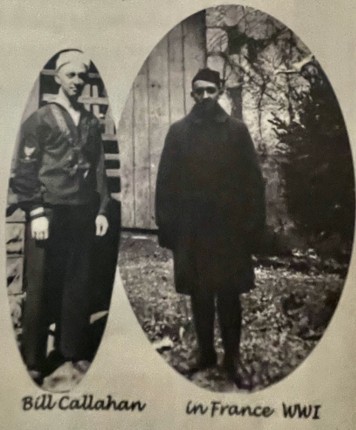
Helen (Mudi) Kavanaugh's Uncle Bill, her mother's youngest brother. Source: Kavanaugh Family Files
My only other war related memories involved a German fellow who
was dating the daughter of one of our neighbors. There was no animosity towards him,
but he did get teased. I remember Jr.
and Louis Callahan (Uncle Jerry's son) would sell newspapers to him, calling out, "Extra, Extra, -News of the war with Germany!!". They'd sell a paper to him, then run away like hell before he'd realize it was a day old paper. Even during the couple's
wedding, Jr., Louis, and Teddy Vallee played a prank on that poor fellow.
WP was influential in Bay City business
affairs, and about 1919 or 1920 he was asked to run for the board of elections. In the process of preparing to do so, he discovered
he was not a U.S. citizen, so had
to apply for citizenship and take the test.
WP had been voting all this time, but to be sure that he passed, he felt
he needed to study for the test. Jr. and I teased Dad about needing to do his homework
and study for his big test. When I was in 10th
or 11th grade,
WP bought a fur coat for my Aunt Madeleine and bought one for me as well. I was really proud of that raccoon coat and wore it to school even in the spring. One day,
in early May, I had worn it to school. In those days girls were not allowed to wear short sleeves at school. If girls had short sleeved outfits
they could wear "sleevelets" which were long gloves with the hands cut out. I had a short sleeved
outfit on that day and got caught. After lunch, the
nun teaching the class called me on my short sleeves. I couldn't find my sleevelets,
so Sister told me to put on my coat. Rather than borrow a friend's jacket, I put on
my raccoon coat. I got a huge laugh when I sashayed out of the cloakroom
wearing that coat, but Sister got the last laugh when she made me wear that big heavy
coat for the rest of the HOT, HOT afternoon. 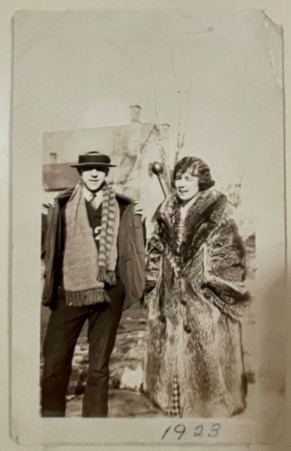
Helen
Kavanaugh (Mudi) and John McGinty (1923). Source: Kavanaugh Family files. After high school, I went to college at Mary Wood in Grand Rapids, Michigan which was a long ride on the Michigan Central Railroad. (Today, it's about
a two hour ride by car) I had gained enough weight by the time I arrived home at
Easter, that I had to wear my school uniform all break - it was, let's say, a pleasant
year! The
following year I went to Ypsilanti Normal School which was a two-year course of study for teachers. My credits from Mary Wood transferred, so I only spent one year and a summer at the Normal School. (The normal school was incorporated later into Eastern Michigan University's Education Department in Ypsilanti
- The building is still there) My sister-in-law,
Pearl, was there at the same time I was and we stayed in the same boarding house near the school. I graduated from that program, earning a lifetime teaching certificate. In
1927, I got a job in the Detroit School System. They were not hiring too many new
teachers that
year, but because I asked for a black school,
I was hired. Although Lyons Public School was mostly a black school,
I was placed in a portable building about a mile from the main school. The portable
building was in Hamtramack an immigrant (all Polish and Slavic) neighborhood. I
taught Kindergarten & Irene Schindler taught first grade in the adjoining room. We became good friends sharing laughs
about our teaching experiences. I taught there for about two years. I remember one little boy who was a real troublemaker, and although
the kids at the school could barely speak English, this little boy, named Hillary,
sure knew all the English swear words! One day, I was fed up with Hillary's swearing,
so I hustled Hillary into the bathroom and showed him the bar of soap, threatening to
wash his mouth out with it. Later that day, I got worried that the parents
would get upset, so confessed to the principal
what I'd done. The parents were called and Hillary's father came to the conference. He was
a big, burly fellow. After hearing the story,
he stood up and took off his belt. I was afraid he was going to hit me with it -
instead he handed the belt to me, saying, "If he swears again, use this!"
Tuesday, March 11, 2025
HALL OF FAME INDUCTEES VISIT THE MUSEUM
by Gary Johnson Musicians Larry McCray and Drew Abbott visited the Historical Museum recently to receive their framed induction certificates to the Michigan Rock and Roll Legends
Hall of Fame.
Larry McCray, who currently resides in Bay County, has emerged as one of Michigan’s top blues artists during
the past three decades. Born in Arkansas in 1960, his family moved to Saginaw in 1972 to take advantage of the economic opportunities
offered in Michigan’s automotive plants. It was there that Larry was introduced to the guitar and the transformative
music of important blues artists by his older sister, Clara. After graduating from high school, Larry took a job at a local General Motors assembly plant and began performing
at area bars and music clubs with his brothers Carl (bass) and Steve (drums) as the McCray Brothers. Larry’s guitar and vocals attracted the attention of Point Blank Records, and his first
two albums for the label, “Ambition” (1990) and “Delta Hurricane” (1993), garnered critical acclaim
for creating an exciting contemporary blues sound by fusing blues, rock, and soul. Throughout the years, Larry continued to help define blues rock by collaborating with artists
such as fellow guitarist Albert Collins, who was also signed to Point Blank. Playing music on national stages also allowed
him to meet and get to know on a first name basis blues heroes such as B.B. King, Buddy Guy, Albert King, Junior Wells, and
Luther Allison. In recent years, Larry has begun working
with Joe Bonamassa. “Blues Without You” was released in 2022, and he has a new album on Bonamassa’s label
set to come out in 2025. Drew Abbott was inducted into
the MRRL HOF as the lead guitarist for Bob Seger & The Silver Bullet Band. Drew is a native Michigander who started his
musical journey on drums before switching to rock guitar following the advent of The Beatles. He first gained attention as the lead guitarist in Third Power, a three-piece band that recorded
one album in 1970. After Third Power disbanded, Drew joined Bob Seger’s Silver Bullet Band in 1974 and appeared on Seger’s
“Seven” album. Starting with the “Beautiful
Loser” album in 1975, Drew was featured on six consecutive platinum albums by Bob Seger & The Silver Bullet Band.
The list included both the “Live Bullet” album, recorded at Detroit’s Cobo Arena, and the “Night Moves”
studio album from 1976, “Stranger in Town” (1978), the Grammy-winning “Against the Wind” (1980), and
a second live album, “Nine Tonight,” released in 1981. He left the Silver Bullet Band in the early ‘80s over a disagreement regarding Seger’s use of session
musicians on his studio recordings. Drew moved to Traverse City to start a family, and he went on to play in several different
bands in the years since. Drew and Bob Seger were reunited
in 2004, however, when Seger asked him to take the stage at his induction into the Rock and Roll Hall of Fame in Cleveland. Learn more about the Michigan Rock and Roll Legends Hall of Fame.
1:04 pm edt
Tuesday, March 4, 2025
GUEST BLOGGER: MUDI'S MEMOIRS - PART 3
Part 3: 1916 to 1919. Family life, Grade School Years
Written and told by Helen Kavanaugh Tobbe (1905-2002) and transcribed by her youngest child,
Kate Tobbe Ptak My brother Jack was a cute little kid. He was about seven years younger than Jr. and
I were. One day, when he was in third grade, he was walking home from school with his friend, Carny, who was from a very poor
family. They were walking past Grandma's house and Carny needed to get to a bathroom soon, so Jack invited Carny into Grandma's
to use the bathroom. Grandma wasn't home at the time. The two boys spotted freshly baked bread and a crock of jam. Jack, who
was a very friendly, hospitable child, invited his friend "poor Carny", to have some bread and jam with him. They
spread that jam nice and thick on their slices of bread. The jam was Grandma's Spring Tonic, made of honey, figs, and senna
(which is a strong laxative). After the snack the boys went on home. Jack didn't mention his visit, but Grandma knew someone
had been there, so she called and warned Nellie that someone was going to be very busy for a while. Well, Jack and “poor
Carny” didn't make it to school for two days - they were too busy. Those boys really cleaned out their systems. “Poor
Carny's” family was too poor to have indoor plumbing, so he really had a lot of running to do!  W.P and Nellie's Children. Bottom right: Helen (11/20/1905-3/4/2004), bottom left: Jack (1/20/1912-8/30/1939), top right:
WP Junior (1/25/1907-2/14/1997), top left: Margaret (4/3/1908-4/9/1996) W.P and Nellie's Children. Bottom right: Helen (11/20/1905-3/4/2004), bottom left: Jack (1/20/1912-8/30/1939), top right:
WP Junior (1/25/1907-2/14/1997), top left: Margaret (4/3/1908-4/9/1996)
I remember Sundays when we
were young. Of course, there was Mass in the morning, dinner, usually a roast chicken dinner with mashed potatoes and gravy,
(our main meal of the day) at noon, then we had to go back to church for Vespers and Benediction at 2:00. We used to pray
that the pastor wouldn't be feeling too good so we'd just have Benediction, as we had other plans starting at 3:30. When we
got out from church, we would run like hell all the way to the movies to get there on time. Pearl White starred in a serial,
The Perils of Pauline, that showed from 3:30 till' 5:00 PM. Each Sunday the movie would close with poor Pauline
hanging from the cliff or running from a Chinaman. What were our school days like? In first grade
we studied reading, spelling, phonics, catechism and math. In later years, geography, history, English, music and art were
added. Of course we had homework, but we would wiggle out of as much as we could. St. James School was located on 12th Street
and just down the street from the school was a blacksmith shop where we stopped every day after school. Did we stop in to
watch the smithy work? No, to hide our geography books which were too heavy to carry all the way home. He never minded or
squealed on us. Of course, our geography grades were seldom in the passing stage. We also went
home at noon every day for dinner. One time, Jr. and I were walking home for dinner with some cousins. As we approached the
cousins' house, we could smell freshly made bread and homemade catsup. Somehow, we wiggled our way in for dinner with them.
No one let Nellie know that we were there, and she got worried when we didn't get home as scheduled. Nellie checked with the
school and found that we were back in class, OK, so knew that we were all right, but Jr. and I sure caught hell when we got
back home later that afternoon. Grandma's house was on the way home from school, and we loved to
stop after school when bread had been baked that day. We also knew the cost - running errands; to the bakery, or maybe six
blocks to the drug store, or to the AOH (Ancient Order of Hibernians) with the insurance dues. Many times, we took a longer
route home. 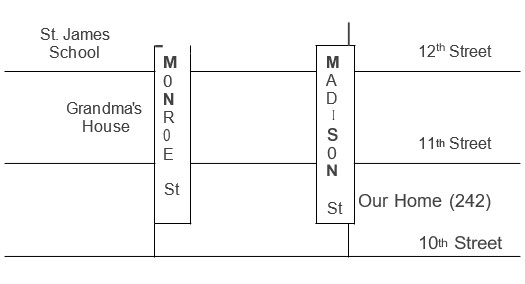
We had a sweet old nun for eighth grade who was so cross-eyed we never knew just who she was pointing
to when calling on students for answers. We got lots of exercise half getting out of our seats only to find it was Joe in
the next row she was calling on. One subject taught in the 8th grade was Indian Lore. WP had brought
home a statue of an Indian which he placed on top of the mantel in our living room. Nellie hated that "awful" thing,
so when she heard about the Indian Lore lessons, she quickly donated the statue to the class.
 I was fourteen when I started driving. There was no such thing as a driver's
license in 1919. WP had bought an old car for us, an Oakland. We and our friends referred to it as the Puddle Jumper. The
top had worn out, so the car was a permanent convertible. One friend, Mary Brysselbout, was a few years older than I. She
could play the organ and piano by ear. She played the organ at church for early Mass. I would take her to church in the Puddle
Jumper. If it was raining that particular day, Mary would open her umbrella to keep both of us dry. The car didn't last very
long with our family as Jr. smashed up the car by driving it into a ditch. I was fourteen when I started driving. There was no such thing as a driver's
license in 1919. WP had bought an old car for us, an Oakland. We and our friends referred to it as the Puddle Jumper. The
top had worn out, so the car was a permanent convertible. One friend, Mary Brysselbout, was a few years older than I. She
could play the organ and piano by ear. She played the organ at church for early Mass. I would take her to church in the Puddle
Jumper. If it was raining that particular day, Mary would open her umbrella to keep both of us dry. The car didn't last very
long with our family as Jr. smashed up the car by driving it into a ditch.
Photo of a 1916 Oakland Car Model 32 B. Mudi's "Puddle
Jumper" probable looked something like this, without the top. (Source: IMCDb.org)
2:47 pm est
|

|
2025.05.01
2025.04.01
2025.03.01
2025.02.01
2025.01.01
2024.07.01
2024.06.01
2024.05.01
2024.04.01
2024.03.01
2024.02.01
2024.01.01
2023.12.01
2023.11.01
2023.10.01
2023.09.01
2023.08.01
2023.07.01
2023.06.01
2023.05.01
2023.04.01
2023.03.01
2023.02.01
2023.01.01
2022.12.01
2022.11.01
2022.10.01

|




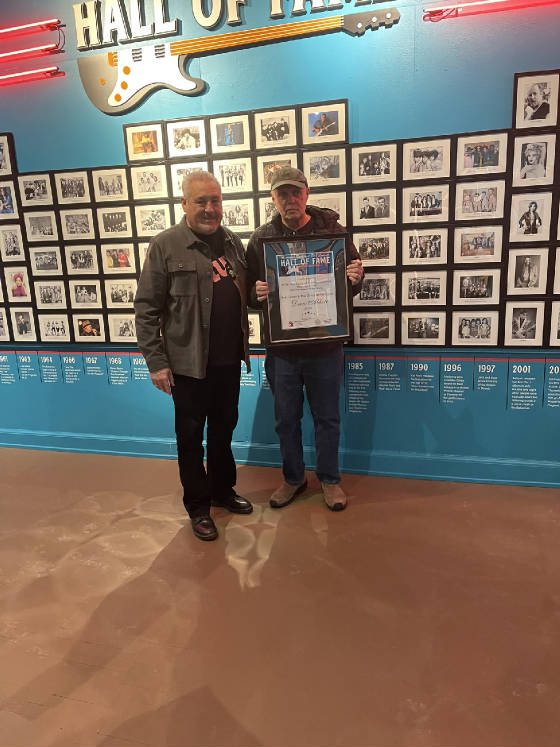
 W.P and Nellie's Children. Bottom right: Helen (11/20/1905-3/4/2004), bottom left: Jack (1/20/1912-8/30/1939), top right:
WP Junior (1/25/1907-2/14/1997), top left: Margaret (4/3/1908-4/9/1996)
W.P and Nellie's Children. Bottom right: Helen (11/20/1905-3/4/2004), bottom left: Jack (1/20/1912-8/30/1939), top right:
WP Junior (1/25/1907-2/14/1997), top left: Margaret (4/3/1908-4/9/1996)




